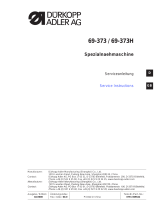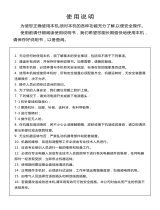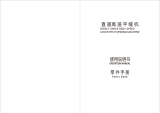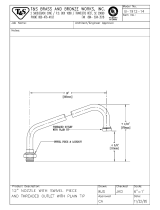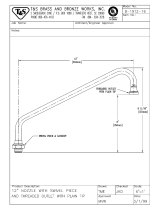Page is loading ...

969
Se rvice Instructions

All rights reserved.
Property of Dürkopp Adler AG and protected by copyright. Any reuse of these contents,
including extracts, is prohibited without the prior written approval of Dürkopp Adler AG.
Copyright © Dürkopp Adler AG 2019
IMPORTANT
READ CAREFULLY BEFORE USE
KEEP FOR FUTURE REFERENCE

Table of Contents
Service Instructions 969 - 06.0 - 03/2019 1
1 About these instructions ........................................................... 5
1.1 For whom are these instructions intended?.................................. 5
1.2 Representation conventions – symbols and characters ............... 5
1.3 Other documents .......................................................................... 7
1.4 Liability.......................................................................................... 7
2 Safety........................................................................................... 9
2.1 Basic safety instructions ............................................................... 9
2.2 Signal words and symbols used in warnings.............................. 10
3 Working basis ........................................................................... 13
3.1 Order of the settings ................................................................... 13
3.2 Laying the cables........................................................................ 13
3.3 Removing and assembling covers.............................................. 14
3.3.1 Access to the underside of the machine..................................... 14
3.3.2 Removing the arm cover ............................................................ 15
3.3.3 Removing the head cover........................................................... 16
3.3.4 Removing the cover plate........................................................... 17
3.3.5 Removing the belt cover............................................................. 17
3.3.6 Removing the thread tension plate............................................. 18
3.3.7 Disassembling the throat plate ................................................... 19
3.3.8 Disassembling and assembling the feed dog ............................. 20
3.4 Flats on shafts ............................................................................ 21
3.5 Axial play for shafts running in plain bearings ............................ 22
3.6 Locking the machine in place ..................................................... 22
3.7 Setting the handwheel into position............................................ 24
4 Positioning the arm shaft......................................................... 25
5 Setting the handwheel scale ................................................... 26
6 Setting the drive ....................................................................... 27
6.1 Setting the drive ratio (Classic)................................................... 27
6.1.1 Disassembling the V-ribbed belt................................................. 27
6.1.2 Setting the drive pulley ............................................................... 28
6.1.3 Setting the belt tension ............................................................... 29
6.2 Setting the drive ratio (heavy transport) ..................................... 30
6.2.1 Disassembling the V-ribbed belt................................................. 30
6.2.2 Setting the drive pulley ............................................................... 31
6.2.3 Setting the belt tension ............................................................... 32
6.3 Setting the positioning of the machine........................................ 33
6.3.1 Importing the drive ratio into the control program....................... 33
6.3.2 Setting the reference position of the handwheel ........................ 34
7 Setting the stitch length adjusting wheel............................... 35
7.1 Setting the upper stitch length adjusting wheel .......................... 36
7.2 Setting the lower stitch length adjusting wheel........................... 37
7.3 Setting the stitch length limit....................................................... 38
7.4 Setting the eccentric for the forward and backward stitches ...... 39
8 Setting the feed dog ................................................................. 40
8.1 Setting the feed dog position ...................................................... 40
8.1.1 Moving the feed dog carrier in sewing direction ......................... 41

Table of Contents
2 Service Instructions 969 - 06.0 - 03/2019
8.1.2 Moving the feed dog sideways ................................................... 42
8.2 Setting the feed dog movement.................................................. 43
8.2.1 Setting the feed movement......................................................... 43
8.2.2 Setting the feed dog height at top dead center........................... 44
8.2.3 Setting the feed dog stroke movement....................................... 45
8.3 Setting the feeding eccentric with adjusting tube ....................... 46
9 Aligning the needle bar linkage............................................... 48
9.1 Moving the needle bar linkage sideways.................................... 48
9.2 Aligning the needle bar linkage in the sewing direction.............. 50
10 Position of the hook and needle ............................................. 51
10.1 Tensioning the hook drive toothed belt....................................... 51
10.2 Setting the dead center of the reciprocating hook movement .... 52
10.3 Setting the loop stroke position .................................................. 54
10.4 Setting the hook clearance ......................................................... 55
10.5 Setting the needle guard ............................................................ 57
10.6 Setting the loop former ............................................................... 58
10.7 Setting the needle bar height...................................................... 59
11 Setting the sewing feet ............................................................ 61
11.1 Setting the sewing foot feed ....................................................... 61
11.1.1 Setting the zero stroke of the sewing feet and the tension
force of the torsion spring ........................................................... 61
11.1.2 Setting the drive dog of the presser foot bar .............................. 63
11.1.3 Setting the feed stroke of presser foot and sewing foot ............. 64
11.1.4 Setting the stroke movement for the feeding foot....................... 66
11.2 Setting the foot stroke................................................................. 67
11.2.1 Setting the foot stroke using the hand lever ............................... 67
11.2.2 Setting the foot stroke using the pneumatic cylinder .................. 68
12 Setting the thread system........................................................ 69
12.1 Setting the thread tension spring................................................ 69
12.2 Setting the winder....................................................................... 70
12.3 Setting the hook thread guide..................................................... 74
13 Setting the thread cutter .......................................................... 75
13.1 Setting the thread cutter timing................................................... 75
13.2 Setting the initial position of the thread cutter and the position
of the thread-pulling knife ........................................................... 76
13.3 Setting the pneumatic cylinder lever........................................... 81
13.4 Setting the cutting pressure........................................................ 82
13.5 Setting the hook thread clamp.................................................... 83
14 Soft start.................................................................................... 84
15 Programming ............................................................................ 85
16 Maintenance.............................................................................. 91
16.1 Cleaning ..................................................................................... 92
16.2 Lubricating .................................................................................. 94
16.3 Servicing the pneumatic system................................................. 96
16.3.1 Setting the operating pressure ................................................... 96
16.3.2 Draining the water condensation ................................................ 97

Table of Contents
Service Instructions 969 - 06.0 - 03/2019 3
16.3.3 Cleaning the filter element.......................................................... 98
16.4 Lubricating the needle bar .......................................................... 99
16.5 Securing the shafts of the stitch length adjusting wheels ......... 100
16.6 Parts list.................................................................................... 102
17 Decommissioning................................................................... 103
18 Disposal................................................................................... 105
19 Troubleshooting ..................................................................... 107
19.1 Customer Service ..................................................................... 107
19.2 Messages of the software......................................................... 107
19.3 Errors in sewing process .......................................................... 113
20 Technical data......................................................................... 115
21 Appendix ................................................................................. 117

Table of Contents
4 Service Instructions 969 - 06.0 - 03/2019

About these instructions
Service Instructions 969 - 06.0 - 03/2019 5
1 About these instructions
These instructions have been prepared with utmost care. They contain
information and notes intended to ensure long-term and reliable operation.
Should you notice any discrepancies or if you have improvement
requests, then we would be glad to receive your feedback through
Customer Service ( p. 107).
Consider these instructions as part of the product and keep it easily
accessible.
1.1 For whom are these instructions intended?
These instructions are intended for:
• Specialists:
This group has the appropriate technical training for performing
maintenance or repairing malfunctions.
With regard to minimum qualification and other requirements to be met by
personnel, please also follow the chapter Safety ( p. 9).
1.2 Representation conventions – symbols and characters
Various information in these instructions is represented or highlighted
by the following characters in order to facilitate easy and quick
understanding:
Proper setting
Specifies proper setting.
Disturbances
Specifies the disturbances that can occur from an incorrect setting.
Cover
Specifies which covers must be disassembled in order to access the
components to be set.

About these instructions
6 Service Instructions 969 - 06.0 - 03/2019
Steps to be performed when operating the machine (sewing and
equipping)
Steps to be performed for service, maintenance, and installation
Steps to be performed via the software control panel
The individual steps are numbered:
First step
Second step
The steps must always be followed in the specified order.
Lists are marked by bullet points.
Result of performing an operation
Change to the machine or on the display/control panel.
Important
Special attention must be paid to this point when performing a step.
Information
Additional information, e.g. on alternative operating options.
Order
Specifies the work to be performed before or after a setting.
References
Reference to another section in these instructions.
Safety Important warnings for the user of the machine are specifically marked.
Since safety is of particular importance, hazard symbols, levels of
danger and their signal words are described separately in the chapter
Safety ( p. 9).
Location
information
If no other clear location information is used in a figure, indications of right
or left are always from the user's point of view.
1.
2.
…
•

About these instructions
Service Instructions 969 - 06.0 - 03/2019 7
1.3 Other documents
The machine includes components from other manufacturers. Each man-
ufacturer has performed a hazard assessment for these purchased parts
and confirmed their design compliance with applicable European and na-
tional regulations. The proper use of the built-in components is described
in the corresponding manufacturer's instructions.
1.4 Liability
All information and notes in these instructions have been compiled in
accordance with the latest technology and the applicable standards and
regulations.
Dürkopp Adler cannot be held liable for any damage resulting from:
• Breakage and damage during transport
• Failure to observe these instructions
• Improper use
• Unauthorized modifications to the machine
• Use of untrained personnel
• Use of unapproved parts
Transport
Dürkopp Adler cannot be held liable for breakage and transport damages.
Inspect the delivery immediately upon receiving it. Report any damage
to the last transport manager. This also applies if the packaging is not
damaged.
Leave machines, equipment and packaging material in the condition in
which they were found when the damage was discovered. This will ensure
any claims against the transport company.
Report all other complaints to Dürkopp Adler immediately after receiving
the product.

About these instructions
8 Service Instructions 969 - 06.0 - 03/2019

Safety
Service Instructions 969 - 06.0 - 03/2019 9
2 Safety
This chapter contains basic information for your safety. Read the instruc-
tions carefully before setting up or operating the machine. Make sure to
follow the information included in the safety instructions. Failure to do so
can result in serious injury and property damage.
2.1 Basic safety instructions
The machine may only be used as described in these instructions.
These instructions must be available at the machine's location at all times.
Work on live components and equipment is prohibited. Exceptions are
defined in the DIN VDE 0105.
For the following work, switch off the machine at the main switch or
disconnect the power plug:
• Replacing the needle or other sewing tools
• Leaving the workstation
• Performing maintenance work and repairs
• Threading
Missing or faulty parts could impair safety and damage the machine.
Only use original parts from the manufacturer.
Transport Use a lifting carriage or forklift to transport the machine. Raise the
machine max. 20 mm and secure it to prevent it from slipping off.
Setup The connection cable must have a power plug approved in the relevant
country. The power plug may only be assembled to the connection cable
by qualified specialists.
Obligations
of the operator
Follow the country-specific safety and accident prevention regulations and
the legal regulations concerning industrial safety and the protection of the
environment.
All the warnings and safety signs on the machine must always be in legible
condition. Do not remove!
Missing or damaged warnings and safety signs must be replaced
immediately.
Requirements
to be met by
the personnel
Only qualified specialists may:
• Setting up the machine
• Performing maintenance work and repairs
• Performing work on electrical equipment
Only authorized persons may work on the machine and must first have
understood these instructions.

Safety
10 Service Instructions 969 - 06.0 - 03/2019
Operation Check the machine during operating for any externally visible damage.
Stop working if you notice any changes to the machine. Report any chang-
es to your supervisor. Do not use a damaged machine any further.
Safety
equipment
Safety equipment should not be removed or deactivated. If it is essential
to remove or deactivate safety equipment for a repair operation, it must be
assembled and put back into operation immediately afterward.
2.2 Signal words and symbols used in warnings
Warnings in the text are distinguished by color bars. The color scheme is
based on the severity of the danger. Signal words indicate the severity of
the danger.
Signal words Signal words and the hazard they describe:
Symbols The following symbols indicate the type of danger to personnel:
Signal word Meaning
DANGER (with hazard symbol)
If ignored, fatal or serious injury will result
WARNING (with hazard symbol)
If ignored, fatal or serious injury can result
CAUTION (with hazard symbol)
If ignored, moderate or minor injury can result
CAUTION (with hazard symbol)
If ignored, environmental damage can result
NOTICE (without hazard symbol)
If ignored, property damage can result
Symbol Type of danger
General
Electric shock

Safety
Service Instructions 969 - 06.0 - 03/2019 11
Examples Examples of the layout of warnings in the text:
This is what a warning looks like for a hazard that will result in serious
injury or even death if ignored.
This is what a warning looks like for a hazard that could result in
serious or even fatal injury if ignored.
This is what a warning looks like for a hazard that could result in
moderate or minor injury if the warning is ignored.
Puncture
Crushing
Environmental damage
Symbol Type of danger
DANGER
Type and source of danger!
Consequences of non-compliance.
Measures for avoiding the danger.
WARNING
Type and source of danger!
Consequences of non-compliance.
Measures for avoiding the danger.
CAUTION
Type and source of danger!
Consequences of non-compliance.
Measures for avoiding the danger.

Safety
12 Service Instructions 969 - 06.0 - 03/2019
This is what a warning looks like for a hazard that could result in
environmental damage if ignored.
This is what a warning looks like for a hazard that could result in
property damage if ignored.
CAUTION
Type and source of danger!
Consequences of non-compliance.
Measures for avoiding the danger.
NOTICE
Type and source of danger!
Consequences of non-compliance.
Measures for avoiding the danger.

Working basis
Service Instructions 969 - 06.0 - 03/2019 13
3 Working basis
3.1 Order of the settings
The setting positions for the sewing machine are interdependent.
Always comply with the order of individual setting steps as specified.
It is absolutely essential that you follow all notices regarding prerequisites
and subsequent settings that are marked with in the margin.
3.2 Laying the cables
To lay the cables:
1. Lay any excess cabling neatly in proper cable snakes.
2. Bind together the cable loops with cable ties.
Tie loops wherever possible to fixed parts.
Important
The cables must be secured firmly.
3. Cut off any overlapping cable ties.
NOTICE
Property damage may occur!
Machine damage from incorrect order.
It is essential to follow the working order specified in these
instructions.
NOTICE
Property damage may occur!
Excess cables can impair the functioning of moving machine parts.
This impairs the sewing function and can result in damage.
Lay excess cables as described.

Working basis
14 Service Instructions 969 - 06.0 - 03/2019
3.3 Removing and assembling covers
For many types of setting work, you will have to remove the machine
covers first in order to access the components. Each explanation of a
setting step includes information on which cover to remove.
This chapter describes how to remove the individual covers. The covers
need to be refitted in reverse order. Re-installation will, therefore, not be
described unless special requirements have to be followed.
3.3.1 Access to the underside of the machine
Cover
To access the components on the underside of the machine, swivel up
the machine head.
Fig. 1: Access to the underside of the machine
CAUTION
Risk of injury from moving parts!
Crushing possible.
Switch off the machine before removing or
re-assembling covers.
(1) - Machine head
(2) - Bartack
(3) - Lever
①
②
③

Working basis
Service Instructions 969 - 06.0 - 03/2019 15
Tilting the machine head
To tilt the machine head:
1. Lift the lever (3).
2. Tilt the machine head (1) as far as it will go.
Erecting the machine head
To erect the machine head:
1. Erect the machine head.
For safety reasons, the machine head (1) is stopped by the bolt (2).
2. Lift the lever (3) and erect the machine head (1) completely.
3.3.2 Removing the arm cover
If necessary, each of the two covers can be removed separately.
Fig. 2: Removing the arm cover
Removing the left arm cover
To remove the left arm cover:
1. Turn left adjusting wheel (2) to position 0.
2. Turn right adjusting wheel (1) to position 8.
Important
The cover cannot be disassembled unless the adjusting wheels are set to
the proper position.
3. Loosen the screws on the left arm cover (3).
4. Lift the left arm cover (3) up and off.
(1) - Right adjusting wheel
(2) - Left adjusting wheel
(3) - Left arm cover
(4) - Right arm cover
(5) - Lever
④
⑤
①
②
③

Working basis
16 Service Instructions 969 - 06.0 - 03/2019
Removing the right arm cover
To remove the right arm cover:
1. Loosen the screws on the right arm cover (4).
2. Raise the right arm cover (4) and disconnect the power plug for the
fan that is attached to the underside of the cover.
3. Lift the right arm cover (4) up and off.
3.3.3 Removing the head cover
Fig. 3: Removing the head cover
To remove the head cover:
1. Loosen the screws (2).
2. Remove the head cover (1).
(1) - Head cover (2) - Screws
①
②

Working basis
Service Instructions 969 - 06.0 - 03/2019 17
3.3.4 Removing the cover plate
Fig. 4: Removing the cover plate
To remove the cover plate:
1. Loosen the screws (2).
2. Remove the cover plate (1).
3.3.5 Removing the belt cover
Fig. 5: Removing the belt cover
To remove the belt cover:
1. Loosen the screws (1).
(1) - Cover plate (2) - Screws
①
②
(1) - Screws
(2) - Handwheel
(3) - Belt cover
(4) - Screws
①
②
③
④

Working basis
18 Service Instructions 969 - 06.0 - 03/2019
2. Remove the handwheel (2).
3. Loosen the screws (4).
4. Remove the belt cover (3).
3.3.6 Removing the thread tension plate
Fig. 6: Removing the thread tension plate
To remove the thread tension plate:
1. Remove the right arm cover (3) ( p. 15).
Important
The thread tension plate is connected to cables and hoses that are
attached below the upper right arm cover.
2. Loosen the screws (2).
3. Remove the thread tension plate (1).
(1) - Thread tension plate
(2) - Screws
(3) - Right arm cover
②
③
①
②
/


